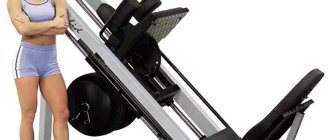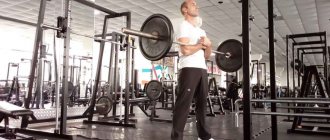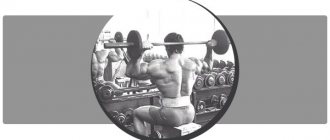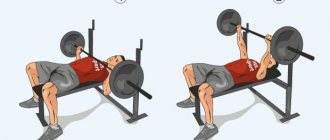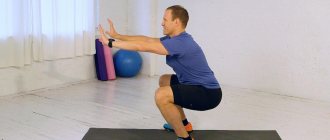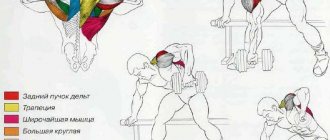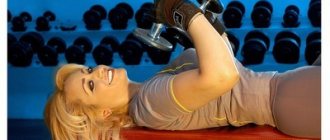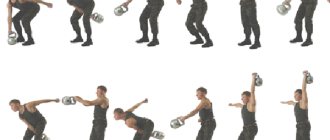October 22, 2020 Admin Home page » Breast
The technique for correctly performing crossovers on the upper blocks, the muscles being trained, the starting position, important tips + video are described.
Anatomy of the rear delts and how to train them
The rear delta is located on the back of the shoulder, that is, at the back of the back. It starts from the lower edge of the scapula and, together with the other bundles, is attached to the tuberosity of the humerus.
Its functions include:
- Retracting the arm back in any plane.
- Rotation (turn) of the hand outward (towards the thumb).
Knowing the function of the rear delts, we now understand the mechanics of their work and how to train them. That is, the main exercises for us will be all kinds of deadlifts with different weights: barbells, dumbbells, cable trainer. But the main thing that we must understand is that in pulling movements the back is actively working, in particular the lats and trapezius.
rear delt exercises
What then should we do to eliminate the back from the exercise?
To begin with, we need to choose the optimal point where we will pull the training equipment we have chosen. Everything is simple here, if you consider that in any back exercises we pull the weight towards the belt, then when training the deltoids you will have to shift the emphasis closer to the chest. This will help eliminate the lats. I suggest, as a guide, to take the center of the pectoral muscles as that very point.
As for the position of the elbows. Basically, when training the rear deltas, the arms are held so that the elbows are in the same plane as the shoulders. That is, if we draw a horizontal line, then the elbows and rear delts will not go beyond it.
Next, you need to choose the right weight
It shouldn't be too light. This way we will simply drown our muscles, but this will not lead to their increase. As for heavy weight, it is also not welcome. Because the deltas will not be able to do it and the back will come to their aid, which will take all the load upon itself. So take the weight that you can pull only due to the force of the deltoids.
Recommendations for effective training
When starting crossover training, it is important to know that weight does not play the main role; first of all, it is an even trajectory of movement and the correct execution technique. It is necessary to bring and spread your arms to the maximum points, this ensures stretching of the pectoral muscles.
It is recommended to perform the first training sessions with a trainer who will help you create a personal training program and teach you how to do everything technically. If it is not possible to seek help from a trainer, it is better to perform the exercises in front of a mirror.
The pectoral muscles have a complex anatomical structure, therefore, to give the breasts an attractive shape, you need to work them with a set of exercises, not forgetting about the other muscle groups of the body. The optimal amount of training in the gym is at least 2 times a week, the load can be gradually increased.
In order for classes to be most effective and without injury, you must not forget about warming up the body. The warm-up usually includes primitive exercises from the school curriculum, such as the traditional “mill”, shoulder rotation and leg swings.
Rear delt exercises
Wide grip barbell row
Let’s start, according to tradition, with a basic exercise, and we definitely won’t find anything better than barbell rows to the chin. It will help increase the mass of our deltas. Of course, there are some technical points that you need to know and take into account when performing this exercise.
Firstly, grip width.
It should be wide so that your arms bend at the elbow and form a 90° angle. If you take a narrower grip, then the entire load will go to the upper part of the trapezius.
Secondly, body positions
. This is a very important point. If we stand straight, we will not be able to engage the rear deltoid. And we will do everything at the expense of the middle one, since the elbows will go up. To avoid this, you need to lean forward a little. Then, when lifting the barbell up, the elbows will go back, which is what we need.
Third, exclude the trapezoid from the exercise.
. This point is very important. After all, if we perform the exercise using the wrong muscles, then we are unlikely to achieve results in their growth. To exclude a trapezoid, you need to perform several actions:
- Select the correct weight of the barbell so that it is not too heavy. The rear deltoid is a small muscle and does not have the same strength as the trapezius.
- Try to stretch your trapezius. To do this, it is enough to spread your shoulders as far as possible to the sides and lower them down a little. This will sort of spread the trapezius across the back and reduce interference.
Technique:
Initial position:
- Take the barbell in your hand with a wide overhand grip.
- Lean your body forward slightly, spread your shoulders to the sides and lower them down.
- Keep your back straight, with a slight arch in your lower back. The chest is pushed forward.
- Feet are shoulder-width apart; for greater stability, you can bend them slightly at the knees.
Performance:
- We take a deep breath and, as we exhale, begin to pull the barbell up until our elbows reach the same line as our shoulders. No need to go any higher.
- After taking a short pause while exhaling, lower the barbell to its original position, stretching the rear deltoids.
Important!
Although the exercise is called a barbell row to the chin, we will pull somewhere around the middle of the chest. So we will load the deltas. If we continue to raise our elbows higher, then the trapezoid will come into play.
Bent over dumbbell swings
I have previously written about this exercise. For a better understanding, I suggest you read this article. You can find it here . I will just say a few key points. This exercise will help pump up the rear deltoids, as well as work each head separately. This is true for those who have developmental delays on either side (for example, many right-handed people have a weaker left hand). Also, there are several options for performing tilted swings. In this article we will look at the simplest of them, this is the standing option. It does not require special training or additional equipment. All we need are two dumbbells.
Execution technique
Initial position:
- Hold a dumbbell in each hand. The grip is neutral, palms facing the body.
- We move the pelvis back and tilt the torso forward. The back is straight, there is a slight arch in the lower back. Gaze forward
- Feet stand shoulder width apart. To increase stability, you can bend them slightly at the knee.
- We stretch the trapezius excluding it from the exercise.
- Dumbbells are lowered down.
The best shoulder exercises in the gym
The specific shoulder exercise program in the gym is tailored to the athlete’s level of training.
The deltoid muscles move the arm to the side, help us bring our arms to the body and raise them above our head. From this follows the set of movements that train them. Seated and standing presses, standing and bent-over rows, as well as lateral raises with dumbbells and forward raises with a barbell or dumbbells are usually sufficient. You can add to the program movements in shoulder machines - lever press machine, crossover, Smith machine, butterfly and lateral abduction machine.
How often to train your shoulders
The shoulders are a lagging muscle group for many athletes. However, specialization is not recommended for beginners after 1-2 years of training, especially in small muscle groups. The main goal should be to increase muscle mass and strength.
Even if the chest grows faster than the deltoids , you should not abandon the bench press in favor of exercises on the shoulders and arms. For such a beginner, on the contrary, it makes sense to stick to the classic split, and work the deltoids on the same day as the leg muscles, giving yourself a day or two of complete rest before training the chest.
Sets and reps
How exactly to choose a set-repetition scheme? It depends on the dominant muscle fiber type. Some people have a “power” build and respond well to working 3-6 reps per set with rest until complete recovery. In others, the deltoid muscles have more “white” fibers and are more durable.
Modes that allow you to spend 30-40 seconds under load, for example, 12-15 or more repetitions in an exercise with a rest of up to 120 seconds between approaches, are well suited for this.
In practice they do the following:
- one of the basic presses - sitting, standing, or sitting in a machine in power mode;
- multi-repetition exercises isolating the middle, anterior and posterior deltoid muscles
How many exercises to include in a shoulder workout? For a natural athlete, it does not make sense to train each muscle bundle with 2-3 exercises. One heavy basic exercise in 2-4 working approaches, and 3-4 approaches of one exercise for each muscle bundle are enough.
Shoulder warm-up
Most injuries to the shoulder joint are caused not by the fact that a person does not warm up enough, but by the fact that he does not pay attention to mobility in the shoulder joint. Often we run on the track to warm up and do circular movements in our shoulders, considering this to be exhaustive work. In fact, the task of warming up is to prepare the joint and muscles for work, and not just to perform some set of “generally accepted” movements.
[youtube >The following scheme is suitable for this purpose:
- general warm-up on an elliptical or rowing machine - 5 minutes;
- rotation in the wrists, elbows, shoulders, hips, knees, ankles. It is enough to perform 5-6 rotational movements in each joint clockwise and counterclockwise;
- one set of light traction to the face. Approach the crossover, position the cable at face level, attach the cable handle and pull with enough amplitude to bring your arms to your shoulders and pull your elbows back, perform 20-25 repetitions with minimal weight;
- one set of the “scarecrow” exercise. Take light dumbbells in your hands and move your forearm perpendicular to the floor and your shoulder parallel. Slowly lower the dumbbells forward in an arced path and lift them to the starting position, 20-25 repetitions;
- one set of dumbbell swings to the sides from a sitting position, minimum weight. Sit on a bench, rest your back against the backrest to prevent body movement. Slowly raise your arms, slightly bent at the elbows, to the sides to a comfortable position (you don’t need to bring them parallel to the floor in the warm-up exercise), and lower them back under control, without throwing the weight.
Tips for Maximum Productivity
Let's reiterate the important points:
- Work with the correct technique, performing movements using the rear deltas.
- Do not make sudden jerking movements. Take care of your shoulders!
- Eliminate the trapezoid from the movement. In order to do this, you need to move your shoulders forward, thereby stretching it across your back.
- If the rear deltas are lagging behind in development, then start shoulder training with them.
- Use dumbbell crossover exercises to correct imbalances between the right and left sides.
- Start training your deltoids with heavy basic exercises. Leave the isolated ones for last.
Raising your arms in front of you from the lower block while sitting on an inclined bench
Targeted muscles:
- anterior head of delta;
- trapezoids.
Execution order:
- set the bench to an inclination in the range of 45°-60°;
- attach a short straight rod or cable to the block;
- take your starting position sitting on a bench and grab the barbell (cable handles), the grip width can vary from narrow to wide;
- at the beginning of each repetition, the arms should be fully straightened and a few centimeters above the hips;
- Moving only your shoulders, slowly raise your arms above your head and hold in this position for 1-2 seconds;
- slowly return to the starting position.
What does the exercise do? This angle provides maximum tension throughout the entire range of motion, which is great for stimulating the growth of the anterior shoulder muscles.
Crossover trainer: design and training features
Almost every gym has a universal block-type device called a crossover. Its classic design consists of two power blocks connected by a frame. There are other modifications of the simulator:
- single-sided block rack;
- corner crossover;
- triple design;
- double block or block frame.
All crossovers are equipped with upper and lower traction blocks, the height of which is adjustable depending on the height of the athlete and the goals of the activity.
Advantages of working in a block simulator
Crossover training is characterized by great variability: here you can influence the target muscles in a variety of ways from different angles.
Working with free weights has many benefits, but it tends to lose some of the load as you return the weight to the starting position with each repetition. This does not happen in a crossover: due to the specifics of the cable-pulley system, muscle fibers actively work regardless of the phase of the exercise.
Any movement in this simulator, due to the cable mechanism, occurs in accordance with a given vector. This minimizes the work of stabilizer muscles and makes it possible to feel the contraction of the target muscles, which is important for beginners. However, if a beginner athlete is interested in gaining muscle mass, he should not avoid basic exercises with free weights.
Working out the shoulder muscles in a crossover
The muscles covering the humerus are the object of intense training for gym goers. The biceps (biceps muscle located on the inside of the shoulder) and triceps (three muscle bundles on the back of the humerus) form an attractive shape of the arms and are an indicator of decent physical shape. To give greater clarity to this area, a crossover is used.
Arm extension on the upper block
The exercise in isolation loads the triceps. It is performed with different handles, but the rope allows you to work in a larger amplitude and makes it possible to “hook” the deepest muscle fibers.
Having secured the selected handle to the upper block, set the weight. Stand facing the machine, slightly tilting your body forward and slightly bending your legs at the knee joints (“soft knees”). You can put one leg forward a little. There is a natural arch in the back, the chest is straightened.
Taking the handle, lower it down so that an angle of 90 degrees or a little more is formed between the forearms and the shoulder.
- Using the force of the triceps brachii muscle, the handle is lowered towards the front surface of the thighs until the arms are fully straightened. Elbows are kept close to the body. Exhalation should coincide with the moment of maximum effort.
- At the bottom point, linger for 1-2 counts, contracting the triceps.
- While inhaling, slowly, without allowing inertial raising of the arms, return to the starting position.
Do 10–15 times in 3–5 sets.
The features, advantages and disadvantages of the exercise are discussed in the video:
Video: Arm extension on the upper block
Bending arms on the upper block
This movement loads the biceps and brachialis, the brachialis muscle located underneath it. It is done while standing on the floor or sitting on a bench.
This exercise will require a double pulley and D-handles attached to the cables in the top position.
- Holding the handles with a reverse grip (wrists away from you), they are located in the central part of the device. It is desirable that the blocks are 30–40 cm above the shoulder line.
- The arms, slightly bent at the elbows, are statically tense and are located in the same plane with the racks of the simulator. The hands are slightly turned towards the head.
- Straining the biceps, while exhaling, pull the handles towards the head.
- When the brushes reach the line of the temples, stop for 1–2 counts.
- Inhaling, slowly and under control bring your hands to the starting position.
Abduction of one arm to the side while lying on a bench
Target muscles : lateral head of deltoid.
Execution order:
- install the bench so that its inclination angle is from 35° to 45°;
- grab the D-shaped handle and take a starting position on the bench, lying on your side (make sure that the position is comfortable for your legs and non-working arm);
- begin to straighten your working arm (PP), holding it a few centimeters above the surface of the thigh;
- slowly raise the PP, keeping it in line with the body, until the deltoid muscle contracts to its maximum;
- hold in this position for 1-2 seconds;
- slowly return to the starting position.
The result of the exercise . At the specified angle of inclination, new muscle groups that are not involved in the usual version of the exercise are involved in a single muscle impulse. In addition, the increased load created by the cable, both at the beginning and end of each repetition, will force the side delts to work harder than they are accustomed to.
Crossover mixing with different body angles
Vertical body position
This version of the initial position is used both for mixing with the upper, middle and lower positions of the handles. The basic mixing technique does not change. The almost complete absence of tilt makes the shoulders more stable and their range of motion more natural. This option is indicated for athletes with shoulder injuries and anterior deltoid overloaded from the bench press.
Slight forward lean
A slight inclination allows you to deepen the stretch of the pectoral muscles and work them out more efficiently with lighter weights. Used in training beginners, legs can be placed either in straddle or in parallel. An important condition is not to change the angle of the body.
Tilt forward 90 degrees
This is an extreme option used in bodybuilding. It gives maximum stretch to the pectoralis major muscle, but involves the entire upper body, and is quite risky for the shoulder joint. This option is not used in fitness, and is not recommended for independent development due to the risk of injury.
Wide-grip lat pull-down while sitting on an incline bench
Targeted muscles:
- latissimus dorsi muscles;
- rhomboid back muscles;
- teres major;
- middle part of the trapezius muscle.
Procedure for performing the exercise:
- Set the incline bench at an angle of approximately 45°;
- place the bench inside the machine,
- take a wide handle;
- take the starting position - grab the handle of the block so that your hands are wider than your shoulders, sit face down on the bench, legs back;
- pull the handle down until the bar touches your chest;
- at the bottom point of the movement, you need to slightly bend your back, move your elbows back and bring your shoulder blades together as much as possible;
- hold in this position for 1-2 seconds;
- return to the starting position.
What does the exercise do? Due to the unique angle of inclination, the entire back muscles contract very strongly, which helps to better feel the muscle connection. In addition, with this use of an incline bench there is no opportunity to impart momentum to the movement that increases fiber activation in the target muscles.
Close-grip lat pull-down while standing on an incline bench
Target muscles : latissimus dorsi (focus on the lower part).
Execution order:
- adjust the angle of the bench in the range from 30° to 70° (change the set position before each approach or new workout);
- attach a V-shaped handle to the cable (if possible, try to find one that is wider than the bench at the top);
- Grasp the handle with your palms and carefully return back to the base of the bench;
- While continuing to stand, to stabilize the position, tilt your chest towards the top of the bench, place your legs behind the line of your back;
- begin to pull the handle towards the lower abdomen, slightly arching your back, keeping your elbows close to your body and your chest raised high;
- control the traction force so that the shoulder blades are brought together as much as possible.
Why do this? Performing the exercise with the bench at this angle allows you to pump up the lower part of the latissimus muscles where they come into contact with the spine. In addition, the incline bench forces you to use a narrow grip, which stimulates the growth of target muscles in thickness.
Raising arms to the sides in a sitting crossover
Target muscles:
- rhomboid muscles;
- middle part of the trapezius muscle;
- posterior head of the delta.
How to do the exercise:
- install a straight bench in the center of the crossover;
- Grab the D-shaped handles and sit so that your torso is about 30 cm in front of the blocks;
- working with your elbows, pull the handles to the sides until you feel your shoulder blades touch;
- to make the contraction even more intense, try to move your elbows slightly back behind your body and down;
- hold this position for 1-2 seconds, focusing on feeling the tension in each muscle in your inner back.
Purpose of the exercise . The movements will pump up and isolate the rhomboids and mid-trapezius. For other muscles involved in movement, the exercise allows for deep work in any position of the back.
Bringing your arms to your chest while lying on an incline bench
Targeted object : clavicular head of the pectoral muscle.
How to do the exercise:
- set the bench at an incline of approximately 75°;
- place it centrally inside the simulator;
- adjust the cables so that when you grip the handles, your shoulders are at an angle of about 70° in relation to your torso;
- from a standing position, lie with your back on the bench;
- clasp the handles with your palms;
- Having slightly bent your elbows, begin to bring your arms across your body and slightly upward, so that when they meet, they are approximately at the level of your nose;
- hold in this position for 1-2 seconds, squeezing and straining your pectoral muscles;
- gradually relaxing the muscles, slowly return to the starting position.
Biceps curl from the upper block in the simulator
Target muscles:
Procedure for performing the exercise:
- install a short straight barbell (straight handle) on the vertical block of the simulator;
- sit on a bench and put your feet under the bolsters;
- grab the handle with a wide, straight grip (make sure your arms remain straight before starting each rep);
- lean your body back slightly as you lower the barbell down and back behind your head, but do not use your body momentum;
- make sure that the biceps are strongly bent at the bottom of the movement;
- hold for 1-2 seconds;
- slowly return to the starting position.
Why do this? Because this movement raises the elbows above eye level, the biceps becomes a less powerful forearm flexor. This engages the brachialis underneath the biceps, which in turn stimulates the hypertrophy of this muscle. By increasing the mass of the shoulder girdle, the biceps will be “pushed” upward, creating the illusion of a higher peak when the arm is curled.
The best exercises in the gym on blocks
Let's take a look at the 10 best cable exercises and why they should be part of your workout routine.
Seated row of block to the waist
Reason for inclusion : This multi-joint back exercise uses multiple muscle groups and allows for the use of heavy weights. Compared to single-joint exercises, it causes the body to produce more growth hormone and testosterone, which has a positive effect on muscle growth. Here you can also use different grips - narrow, wide, underhand, overhand - to work the muscles in different ways.
Seated row of block to the waist
Placement in Workout : Perform seated rows toward the end of your back workout. When starting out, work with heavy weights on deadlifts, bent-over rows, and/or t-bar rows. To increase your range of motion, perform one-arm rows.
Lower pulley to the chin
Reason for inclusion : This multi-joint machine shoulder exercise is a great way to target your middle deltoids, especially if you use a wider grip. You can achieve greater isolation by performing deadlifts lying on the floor, standing with two cables, or simply sitting. Use a bar with rotating handles to ease the strain on your wrists.
Standing lower block row to the chin
Place in training : Perform after heavy gains in the overhead press and before single-joint delt exercises. You can also use the chin row as a finishing exercise in dropsets if you want to squeeze all the strength out of your middle deltoids.
Upper pulley to chest
Reason for inclusion in the list : this exercise for the back on simulators has a wider range of motion relative to the body compared to rows, in which the arms move mainly perpendicular to it. Again, don't be afraid to experiment and use different types of bar and grip.
Upper pulley to chest
Placement in Workout : Some people like to do lat pulldowns to warm up their shoulders because the exercise has a high range of motion. Unlike pull-ups, you can easily increase the load and perform several heavy sets at the beginning of your back workout.
You can also do free weight exercises after warming up, and then move on to chest rows.
Standing crossover curl
Reason for inclusion : There are many ways to incorporate crossover bicep curl variations into your workouts, but this one is our favorite because it allows you to vary your body position relative to the block and the height of the block. If you have an injured shoulder, then this exercise will provide freedom in the movements of the joint.
One arm crossover curl
Placement in Workout : Crossover curls are great for those times when you want to lower the intensity of your workout. However, in this exercise you can work with fairly heavy weights. When you reach muscle failure, make sure you are not using momentum.
If you practice so-called cheating in a single-joint exercise, this will lead to a violation of the technique, which will increase the risk of injury. If you plan to train in the 6-8 rep range, then perform the exercise with both hands using EZ bars or a barbell.
Bringing hands together in a crossover
Reason for inclusion : One of the main benefits of this chest exercise is that it is easy to vary the angles of resistance. Place the blocks at the top to target the bottom of the pecs or at the bottom to focus on the upper area. Also vary the point at which you bring your hands together.
Place in training : Crossover crossovers are usually the last or penultimate exercise of the workout. If you include 2 isolation exercises in your chest workout, make sure they work the muscles from different angles.
Triset (swings to the side and in front of you + bent over arms)
Reason for inclusion : In fact, cable machines were designed to perform single-joint exercises. Thanks to these devices, you can make a triset for each bunch of deltas without letting go of the handle. For example, a triset of raising your arms while standing or bending over, as well as raising your arms in front of you and swinging to the sides.
Exercises on the shoulder block
Place in the workout : As a rule, single-joint delt exercises are performed at the end of the workout. However, you can do them at other times, the main thing is that all the beams are worked out equally well.
Abdominal crossover crunches
Reason for inclusion : Unlike bodyweight exercises, crossover crunches allow you to adjust the load and train for any number of repetitions depending on your goals. What's more, you can do this exercise standing or on your knees to target your upper abs, and doing one-arm crunches while standing will help you target your obliques better.
Press crunches on the upper block
Workout Placement : Make crossover crunches the first or second exercise in your ab workout. You can also use lighter weights for more reps when performing the exercise towards the end of your workout.
Arm extension in crossover with rope
Reason for inclusion : This exercise works great on the long head of the triceps. It is much easier to return to the starting position here than when using dumbbells or an EZ bar. You can also add variety and perform this exercise with a regular handle, on your knees, or with one hand.
Extension of arms with a rope from behind the head for triceps
Placement in Workout : If you do compound exercises first in your triceps workout, you can do crossover curls any time afterward.
Arm adduction and abduction in crossover
Reason for inclusion : You might think that rotator cuff training is a waste of time, but it's not. This group of tendons and muscles works in conjunction with the deltoid muscles to provide stability to the shoulder joints and help us avoid injury.
The problem starts when you focus too much on your deltoids and not enough on your rotator cuff. When this happens, you create an imbalance in the development of muscle groups, which leads to dire consequences for shoulder health. If you want to do arm adduction and abduction with a dumbbell instead of a crossover, do it while lying down rather than standing.
Triceps extensions lying on an incline bench
Target muscles : triceps.
Procedure for performing the exercise:
- set the bench to an inclination angle of approximately 45°;
- install the bench in the crossover so that the distance between its end part and the center of the machine is 60-90 cm (when you lean back on the bench, your head should be closer to the weight than your legs);
- Attach a horizontal handle or rope handle to the cable, which must be interchanged before performing each new approach or at the beginning of the next workout;
- sit down and lean back on the bench, ask the assistant to give you the handle;
- elbows spread out to the sides should be in line with the torso (they must be held in this position throughout the entire set);
- Instead of lowering the handle straight down, you will have to perform a movement that combines elements of extension and thrust at the same time;
- continue the movement until the muscles contract completely and hold this position for 1 second;
- slowly return to the starting position.
Result : the exercise, being a combination of triceps rows and extensions, combines the best of them in terms of enhanced impact on the triceps.
Mixing on a crossover in different racks
Information in all three mounting options is performed while standing in two possible positions:
- In a straddle or “scissors” position, take the starting position as for a lunge, the front leg is slightly bent at the knee, the back leg is straight, but stands on a full foot;
- The thighs are parallel to each other, the starting position is achieved by slight flexion at the hip joint
The stand option is chosen depending on how the case is more stable. The main condition is the absence of a forward push with the body during each repetition. The stand itself is not important. If scissors are used, it is advisable to switch legs with each rep to avoid imbalance.
Bent-over arm extension on a lower block
Target muscles : triceps.
Procedure for performing the exercise:
- grab the end of the cable of the upper block (preferably the tip);
- bend towards the floor at a right angle;
- bend your legs slightly, place the elbow of your non-working arm on your knee;
- hold the cable so that the movement can be performed with a hammer grip;
- starting with the triceps, at full stretch, slowly straighten your elbow until your arm is straightened and the triceps are fully contracted;
- hold in this position for 1-2 seconds;
- return to the starting position.
Why do this? The unique positioning of the arm and torso makes this exercise similar to concentrated biceps hammer curls. When the movement is performed absolutely correctly, the triceps muscles contract extremely strongly, which ensures rapid mass growth.
Secrets and subtleties of the exercise
While performing, you need to remember the points that will help you train more effectively:
- Never straighten your arms completely, as this will stretch the muscles too much. If you use a lot of weight, this can lead to them breaking. In addition, by keeping your lats and biceps under constant tension, you train them much more effectively.
- Only muscle force should be used. You should do the deadlift, not the overhead pulley jerk. By incorporating the force of inertia into your work, you significantly reduce the load on your muscles.
- For greater training effectiveness, alternate exercise variations. Use the same method for no more than 2-3 weeks, then change it. Remember, you can use different grips and hand positions, as well as different handles. All this will lead to more effective muscle growth.
- At the lowest point, bring your shoulder blades together and tighten your muscles as much as possible.
- The back should be straight. Only natural deflection of the lower back is allowed.
- Elbows should move up and down along the body, without deviating to the sides.
- You need to perform repetitions so that the handle is approximately at the level of the center of the chest.
The lat pulldown allows you to specifically work the latissimus dorsi muscles and is an excellent alternative to pull-ups.
By changing the position of the hands and grip, you can change the emphasis of the load, which will be an excellent stimulus for muscle growth of this muscle group. A large number of variations will also allow you to diversify the training process. Video exercises: vertical pull-down
Bicep curls while sitting on an incline bench
Target muscles:
Procedure for performing the exercise:
- give the bench an inclination angle of approximately 45° and place it in front of the upper crossover block;
- Attach a horizontal handle to the cable (or a rope handle if you want to perform hammer bends);
- grab the handle and lie with your back on the bench;
- at the beginning of each repetition, the arms should be straight and directed upward towards the block;
- Without using your shoulders or forearms, slowly pull the cable towards your forehead, continuing this movement until it touches;
- Flexing your biceps as hard as possible, hold the peak contraction for 1-2 seconds;
- slowly return to the starting position.
Why do you need to do the exercise? As your arms are extended in front of you, the traction will act on the brachialis, stimulating its growth. The increase in biceps directly depends on this factor. Thus, the brachialis plays the role of the “great mass builder.” In addition, strict adherence to the exercise technique provides a powerful, unparalleled contraction of the biceps, which leads to a rapid increase in its volume.
Crossover squats
Target muscles:
Performing the exercise:
- grab the horizontal handle or cable attached to the lower block and step back;
- when the weights, having risen, create tension in the cable, keeping your arms straight, squat down, as if you were sitting on a low bench behind your buttocks;
- when your thighs are parallel to the floor (or just below this point), hold in this position for 1 second;
- Stressing your quadriceps and glutes as much as possible, slowly return to the starting position.
Why do this? The exercise is an excellent alternative to squats in various machines and basic squats. Its peculiarity is that the load on the muscles when squatting is distributed from the bottom up, and not from the weight on the upper back.
Shoulder exercises in the gym
Basic presses
- Sitting
Performed with a free barbell or in a Smith machine. The back of the bench is at an angle that allows you to sit comfortably (usually a little “softer” than perpendicular).
The projectile is removed from the racks and lowered to the top of the chest. From here, a smooth upward press is carried out due to extension at the elbow joint.
The peculiarity is that the sitting position does not allow you to “pull” the body under the barbell, which reduces the amplitude of work in the shoulder joint. The movement is performed until the chest touches in each repetition, but without pauses at the top and bottom.
- standing
Recommended for experienced athletes with the skills to maintain a neutral back and toned abs while working. But even for them, a weightlifting belt is recommended during this exercise.
You should take the barbell from the racks with a medium grip and squeeze it up; from the second third of the movement, a little work with the body forward is allowed so that the projectile at the top point goes behind the head and is not projected onto the top of the head.
This is acceptable by movement standards, but sliding your hands along the bar, “beating” from the chest and pointing your elbows to the sides is not.
- With dumbbells
It is recommended that the dumbbells be handed over by a spotter, or that they be thrown from the front of the thighs using the legs alternately. The press is performed with the palms turned forward, in one smooth movement along a straight path, and the dumbbells are lowered back in the same way.
There is the so-called “Arnold press” - an option in which the forearm is placed on the body and the dumbbells are rotated during the press.
For the middle fascicle of the deltoid muscle
- Deadlift standing
Performed with dumbbells, barbell or crossover block. You need to stand up straight, hold the projectile straight with your arms down, then pull it up to your chin, bring it up to your chin, and lower it down again.
The elbows move up, the grip should be shoulder width apart or slightly narrower. The narrower the grip, the more the trapezius muscle works.
- Lateral abductions with dumbbells
Stand straight, dumbbells in your hands, the barbells of the apparatus are parallel to each other. With a slight tilt of the body forward and bent elbows, move your arms to the sides and lower them down to the starting position. You should not aggressively straighten your elbows and throw the dumbbells towards your head. It is necessary to avoid a swinging style of work so that the muscles are used more fully.
For the posterior deltoid muscle
- Arm raises in the butterfly simulator
You need to sit facing the back of the machine and fix the handles in the extreme position. Using the force of the posterior bundles of the deltoid muscles, move your arms back and squeeze your shoulder blades together, and smoothly return back.
For the anterior deltoid muscle
- Barbell forward raises
You need to stand straight, hands shoulder-width apart, lift the barbell forward to shoulder level and smoothly lower it. Body swaying and work by inertia are eliminated.
Shoulder training can be done with minimal equipment. Free weights are preferred. Working in simulators only allows you to more quickly adjust the working weight when performing drop sets, as well as completely eliminate the core from work during the movement.

